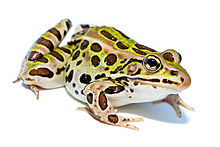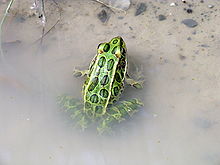- Northern Leopard Frog
-
Northern Leopard Frog 
Conservation status Scientific classification Kingdom: Animalia Phylum: Chordata Class: Amphibia Order: Anura Family: Ranidae Genus: Rana Species: R. pipiens Binomial name Rana pipiens
Schreber, 1782Synonyms Lithobates pipiens
Dubois, 2006The Northern Leopard Frog (Rana pipiens[1][2][3]) is a species of leopard frog from the true frog family, native to parts of Canada and United States. It is the state amphibian of Minnesota and Vermont.
Contents
Physical description
The Northern Leopard Frog is a fairly large species of frog reaching about 11 centimeters (4.3 inches) in length. It varies from green to brown in dorsal colour with large dark circular spots on its back, sides and legs. Each spot is normally bordered by a lighter ring. A pair of dorsolateral folds starting from the back of the eye run parallel to each other down the back. These dorsolateral folds are often lighter or occasionally pinkish in colour. There is also a pale stripe running from the nostril, under the eye and tympanum, terminating at the shoulder. The ventral surface is white or pale green. The iris is golden and toes are webbed. Tadpoles are dark brown or grey, with light blotches on the underside. The tail is pale tan.
Ecology and behavior
Northern Leopard Frogs have a wide range of habitats. They are found in permanent ponds, swamps, marshes and slow moving streams throughout forest, open and urban areas. They normally inhabit water bodies with abundant aquatic vegetation. They are well adapted to cold and can be found above 3,000 m (9,800 ft) asl. Males make a short snore-like call from water during spring and summer. The northern leopard frog breeds in the spring (March–June). Up to 6500 eggs are laid in water, and tadpoles complete development within the breeding pond. Tadpoles are light brown with black spots, and development takes 70–110 days, depending on conditions. Metamorph frogs are 2–3 cm (0.79–1.2 in) and resemble the adult.
This species was once quite common through parts of western Canada until declines started occurring during the 1970s. The population decline is thought to have been caused by pollution drift from the United States falling in the form of acid rain. Many populations of Northern Leopard Frogs have not yet recovered from these declines.
Northern Leopard Frogs are preyed upon by many different animals such as snakes, raccoons, other frogs and even humans. They do not produce distasteful skin secretions and rely on speed to evade predation.
They eat a wide variety of animals including crickets, flies, worms, and smaller frogs. Using their large mouths, they can even swallow birds and garter snakes. This species is similar to the Pickerel frog (Rana palustris) and the Southern Leopard Frog (Rana sphenocephala).
Research
Medical
The Northern Leopard Frog produces specific ribonucleases in its oocytes. Those enzymes are potential drugs for cancer. One such molecule called ranpirnase (onconase) is in clinical trials as a treatment for pleural mesothelioma and lung tumours. Another called amphinase was recently described as a potential treatment for brain tumors.[4]
Neuroscience
The Northern Leopard Frog has been a preferred species for making discoveries about basic properties of neurons since before the 1950s. The neuromuscular junction of the sciatic nerve fibers of the sartorius muscle of this frog has been the source of a lot of initial data about the nervous system.[5][6][7][8][9][10]
Muscle physiology and biomechanics
The Northern Leopard Frog is a popular species for in vitro experiments in muscle physiology and biomechanics due to the ease of accessibility for investigators in its native range and the ability of the sartorius muscle to stay alive in vitro for several hours. Furthermore, the reliance of the frog on two major modes of locomotion (jumping and swimming) allows for understanding how muscle properties contribute to organismal performance in each of these modes.
Footnotes
- ^ Hillis, D. M. 2007. Constraints in naming parts of the Tree of Life. Molecular Phylogenetics and Evolution 42:331-338.
- ^ Hillis, D. M., and T. P. Wilcox. 2005. Phylogeny of the New World true frogs (Rana). Molecular Phylogenetics and Evolution 34:299-314.
- ^ Pauly et al. (2009)
- ^ Frog molecule could provide drug treatment for brain tumors
- ^ Fatt & Katz 1952 "Spontaneous subthreshold activity at motor nerve endings" J Physiol. 117: 109-128.
- ^ Del Castillo & Katz 1954a "Quantal components of the end-plate potential" J Physiol. 124: 560-573
- ^ Katz & Miledi 1965 "The measurement of synaptic delay, and the time course of acetylcholine release at the neuromuscular junction. Proc. R. Soc. B 161:483-495.
- ^ Kuffler & Yoshikama 1975 "The number of transmitter molecules in a quantum: an estimate from iontophoretic application of acetylcholine at the neuromuscular synapse" J. Physiol. 251: 465-482.
- ^ Hille 1967 "The seelctive inhibition of delayed potassium currents in nerve by tetraethylammonium ion. J. Gen Physiol. 50: 1287-1302.
- ^ Voltage clamp analysis of acetylcholine produced end-plate current fluctuations at frog neuromuscular junction" J.Physiol. 235:655-691.
See also
References
- Hillis, D.M., Frost, J.S.,& Wright, D.A. (1983): Phylogeny and biogeography of the Rana pipiens complex: A biochemical evaluation. Systematic Zoology' 32: 132-143.
- Hillis, D.M. (1988): Systematics of the Rana pipiens complex: Puzzle and paradigm. Annual Review of Systematics and Ecology 19: 39-63.
- Hillis, D.M. & Wilcox, T.P. (2005): Phylogeny of the New World true frogs (Rana). Mol. Phylogenet. Evol. 34(2): 299–314. doi:10.1016/j.ympev.2004.10.007 PDF fulltext.
- Hillis, D. M. (2007) Constraints in naming parts of the Tree of Life. Mol. Phylogenet. Evol. 42: 331–338.
- Pauly, Greg B., Hillis, David M. & Cannatella, David C. (2009): Taxonomic freedom and the role of official lists of species names. Herpetologica 65: 115-128. PDF fulltext
External links
- BBC news item re. Rana pipiens and the treatment of brain tumours
- Northern Leopard Frog (Rana pipiens), Natural Resources Canada
Categories:- IUCN Red List least concern species
- Lithobates
- Rana
- Model organisms
- Symbols of Vermont
- Amphibians of the United States
- Amphibians of Canada
Wikimedia Foundation. 2010.



